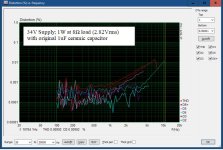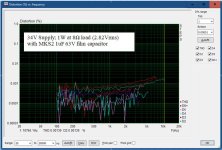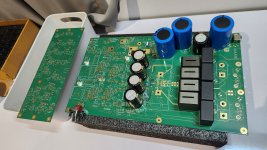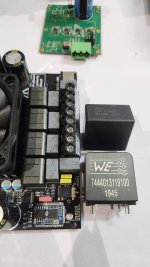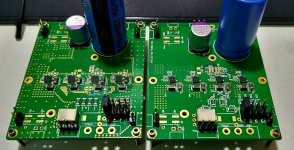Last edited:
Probably not X7R but lower quality ceramic caps. Film caps usually do a better job there just as in the inputs.
yes , those 4 ceramics will be replaced.
I will also bypass the two input 10 uF capacitors , my dac has dc protection at rca out.
The card quality is surprisingly high 🙂

I will also bypass the two input 10 uF capacitors , my dac has dc protection at rca out.
The card quality is surprisingly high 🙂
Last edited:
That are the outputs 🙂
BTW why not build the SMPS in the casing with a shield? With a filtered/fused/switched IEC mains inlet all is easy and good.
BTW why not build the SMPS in the casing with a shield? With a filtered/fused/switched IEC mains inlet all is easy and good.
Maybe I’ll do that later … first trying with an external 36V brick . The sound must be on par with my Hypex ncore and aiyima a04 tpa3251 before investing more .
Tombo56's R21 is a very good alternative over SMPS. Linear is better than the average SMPS anyway. A new complete PSU version is coming out I think.
I had a similar one and already threw it away. All low-cost TPA3255 boards on the market use a single supply with low-quality coupling capacitors. If you want to replace them with high-quality capacitors, there is no space because they are very bulky. Additionally, the voltage regulators on these boards are of poor quality. I do believe that all the components on the board are also low quality.
I developed the second revision of the TPA3255 PCB, incorporating PFFB. The design includes a TPS7A470x powering an LT3045 for the positive rail (POS) and a TPS7A3301 powering an LT3094 for the negative rail (NEG), both embedded in the PCB.
You should look for a board that uses a dual supply for the opamp to eliminate the need for coupling capacitors. Key components such as the LC output filter, low-noise high-PSRR linear regulators, resistor and capacitor size/type, and PCB layout play a crucial role. I designed it with a high-cost approach, but it feels great. For this version I do not finish yet. All the opamps on the board are single opamps, allowing me to use OPA1611, OPA627, AD797, LT1028, and my custom discrete opamp as well.
The picture below shows a comparison between the LC filter components on a Chinese board and the LC filter that I use.
In summary, it is not great, but it is okay depending on your satisfaction. If budget is not a concern, Orchard Audio Starkrimson, Hypex, and other high-end options are better choices. The $245 TPA3255 evaluation board from Texas Instruments might be the answer in term of low price and good quality.
I developed the second revision of the TPA3255 PCB, incorporating PFFB. The design includes a TPS7A470x powering an LT3045 for the positive rail (POS) and a TPS7A3301 powering an LT3094 for the negative rail (NEG), both embedded in the PCB.
You should look for a board that uses a dual supply for the opamp to eliminate the need for coupling capacitors. Key components such as the LC output filter, low-noise high-PSRR linear regulators, resistor and capacitor size/type, and PCB layout play a crucial role. I designed it with a high-cost approach, but it feels great. For this version I do not finish yet. All the opamps on the board are single opamps, allowing me to use OPA1611, OPA627, AD797, LT1028, and my custom discrete opamp as well.
The picture below shows a comparison between the LC filter components on a Chinese board and the LC filter that I use.
In summary, it is not great, but it is okay depending on your satisfaction. If budget is not a concern, Orchard Audio Starkrimson, Hypex, and other high-end options are better choices. The $245 TPA3255 evaluation board from Texas Instruments might be the answer in term of low price and good quality.
Attachments
I've bought the TI evaluation board more than ten years ago when there was a considerable discount. It's a good and versatile board, exactly what it has been designed for, and it sounds good (= neutral), too. Anyway, it has the big disadvantage of the big electrolytics sticking our from the wrong side.
Best regards!
Best regards!
- Home
- Amplifiers
- Class D
- Is this a good sounding TPA3255 board?
